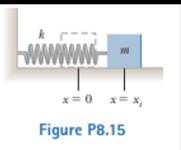A 12-kg block on a horizontal frictionless surface is attached to a light spring (force constant = 0.80 kN/m). The block is initially at rest at its equilibrium position when a force (magnitude P= 80 N) acting parallel to the surface is applied to the block, as shown. What is the speed of the block when it is 13 cm from its equilibrium position?
Given data:
Mass of the block, \[m=12\text{ kg}\]
Spring constant, \[k=0.80\text{ kN/m = 800 N/m}\]
Force, \[F=80\text{ N}\]
Elongation in the spring, \[x=13\text{ cm = 0}\text{.13 m}\]
Applying the conservation of energy:
\[\begin{align}
& F.x=\frac{1}{2}k{{x}^{2}}+\frac{1}{2}m{{v}^{2}} \\
& \therefore \\
& {{v}^{2}}=\frac{2\left( F.x-\frac{1}{2}k{{x}^{2}} \right)}{m} \\
& v=\sqrt{\frac{2\left( F.x-\frac{1}{2}k{{x}^{2}} \right)}{m}}
\end{align}\]
Plugging in the given values:
\[\begin{align}
& v=\sqrt{\frac{2\left( 80\times 0.13-\frac{1}{2}\times 800\times {{\left( 0.13 \right)}^{2}} \right)}{12}} \\
& =0.7788\text{ m/s}
\end{align}\]
Answer:
Speed of the block: 0.778 m/s
A 12-kg block on a horizontal frictionless surface is attached to a light spring (force constant = 0.80 kN/m). The block is initially at rest at its equilibrium position when a force (magnitude P= 80 N) acting parallel to the surface is applied to the block, as shown. What is the speed of the block when it is 13 cm from its equilibrium position?
Given data:
Mass of the block, \[m=12\text{ kg}\]
Spring constant, \[k=0.80\text{ kN/m = 800 N/m}\]
Force, \[F=80\text{ N}\]
Elongation in the spring, \[x=13\text{ cm = 0}\text{.13 m}\]
Applying the conservation of energy:
\[\begin{align}
& F.x=\frac{1}{2}k{{x}^{2}}+\frac{1}{2}m{{v}^{2}} \\
& \therefore \\
& {{v}^{2}}=\frac{2\left( F.x-\frac{1}{2}k{{x}^{2}} \right)}{m} \\
& v=\sqrt{\frac{2\left( F.x-\frac{1}{2}k{{x}^{2}} \right)}{m}}
\end{align}\]
Plugging in the given values:
\[\begin{align}
& v=\sqrt{\frac{2\left( 80\times 0.13-\frac{1}{2}\times 800\times {{\left( 0.13 \right)}^{2}} \right)}{12}} \\
& =0.7788\text{ m/s}
\end{align}\]
Answer:
Speed of the block: 0.778 m/s
